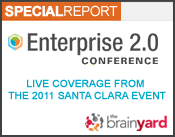How Facebook Manages Its WorkforceHow Facebook Manages Its Workforce
Facebook is growing so fast it had to implement new forms of employee reviews in a "learn or lose" work environment, execs tell Enterprise 2.0 conference.

As a hypergrowth company made up of and designed to serve the generation known as millennials, Facebook can't operate on a six-month employee review cycle.
Speaking at the Enterprise 2.0 conference in Santa Clara, Calif., a UBM TechWeb event, Facebook's Molly Graham noted that when she joined the company in 2008, Facebook had about 80 million users. Today, it has more than 800 million. "You could have been the highest performer in 2008, and you would be underwater today if you hadn't learned anything. The company changes at least every six months because the scale changes," Graham said. That makes for a work environment that is "learn or lose," she said.
Graham is currently part of Facebook's mobile product team but formerly worked in human resources. She gave a presentation along with Nick Stein, director of content and media for Rypple, which has Facebook as a customer for it's system for employee feedback and recognition.
Graham said Facebook agreed to help Rypple design the product because the software was something it needed itself. Prior to adopting Rypple about a year and a half ago, Facebook had already developed an informal system allowing employees to send each other thanks and recognition through an internal discussion board. Rypple turned that into an enterprise product that organizes all that feedback for use in a more formal review process later.
"We add badges for those thanks that reflect specific skills and achievements, and we make that a permanent part of an employee's profile to help build their reputation," Stein said. "Social a word that's getting thrown around a lot today, but it's more than just a buzzword, it's a structured way of thinking," he said. The best social software amplifies the way people want to work anyway, he said.

Enterprise 2.0
Applying social principles to employee feedback meant applying the same principles that have worked on facebook.com, for example, to propel the growth in Facebook photos, Graham said. When Facebook launched its photo sharing site in 2005, many people thought it would have a hard time competing with the dozens of more established photo sharing sites, many of which offered more sophisticated photo handling features. The initial release wouldn't even let you rotate a photo, she noted.
However, Facebook offered the ability to tag friends in photos, which made all the difference, Graham said. It allowed users to associate the photos with people rather than dates or keywords. As a result, Facebook now stores more photos than all the other photo sharing sites combined, she said.
"This product was successful because it was more natural," Graham said. "When we talk about social design as a company, we're talking about taking technology out of the way and building the product in a way that mirrors human behavior."
Facebook wanted its system for providing employee feedback to feel natural in the same way by building it into the news feed of the company's internal discussion board system. Facebook has periodically wrestled with figuring out the right way to handle employee reviews, and at one point tried to dispense with the whole process, Graham said. Employees missed having some process in place, however, because they wanted to be recognized, and fairly compensated, for their achievements.
In general, Facebook did not start out with a lot of formal processes, Graham said. "When we implemented a process, there had to be a good reason. The places we add process is where it lets us collaborate faster, or where there are people doing duplicate work. Our belief is process should make you faster as a company. Where companies get to feeling a little bit big is where they put in process for the sake of process and not actually to solve a problem."
Building social qualities into work processes makes them more efficient because of "the natural interactions that happen if you know and like the people you work with," Graham said. "It actually makes you faster. There's a speed that comes from relationships." For example, even if she hasn't seen a coworker in months, they keep tabs on each other online, which means they have less catching up to do the next time they need to work together.
Ultimately, Facebook decided it needed two processes for recognition and reviews, not one. Rather than giving employee feedback and recognition as part of a six-month review cycle, feedback and recognition needed to become a continual process. The employee's record of accumulated recognition could then feed into the formal review. "Employees want to know how they're doing and how it can be better," Graham said.
Some of this plays into stereotypes about the millennial generation, such as the idea that they are needy, selfish, and impatient--always looking for another gold star on their report cards. As perhaps the first great company to be built by millennials, Facebook tends to instead see positive qualities: employees seeking constant growth, continuous learning, work they can be passionate about, and new challenges.
While its user base has broadened, "the truth is, we started as a site for college kids," Graham said. "Our CEO is a millennial, and Facebook was built as a site for millennials." When other people tell her "The Four-Hour Workweek" by Timothy Ferriss is the bible of her generation, she thinks of how many employees cheerfully compete in all-night hackathons.
"Our idea of fun as a company is people staying up all night working," Graham said. The millennials at her company aren't looking to work less, "they're looking for work that has meaning," she said. "Yes, work-life balance is really important for longevity, but I don't find we're a company of people who are looking to leave."
Follow David F. Carr on Twitter @davidfcarr. The BrainYard is @thebyard
About the Author
You May Also Like






